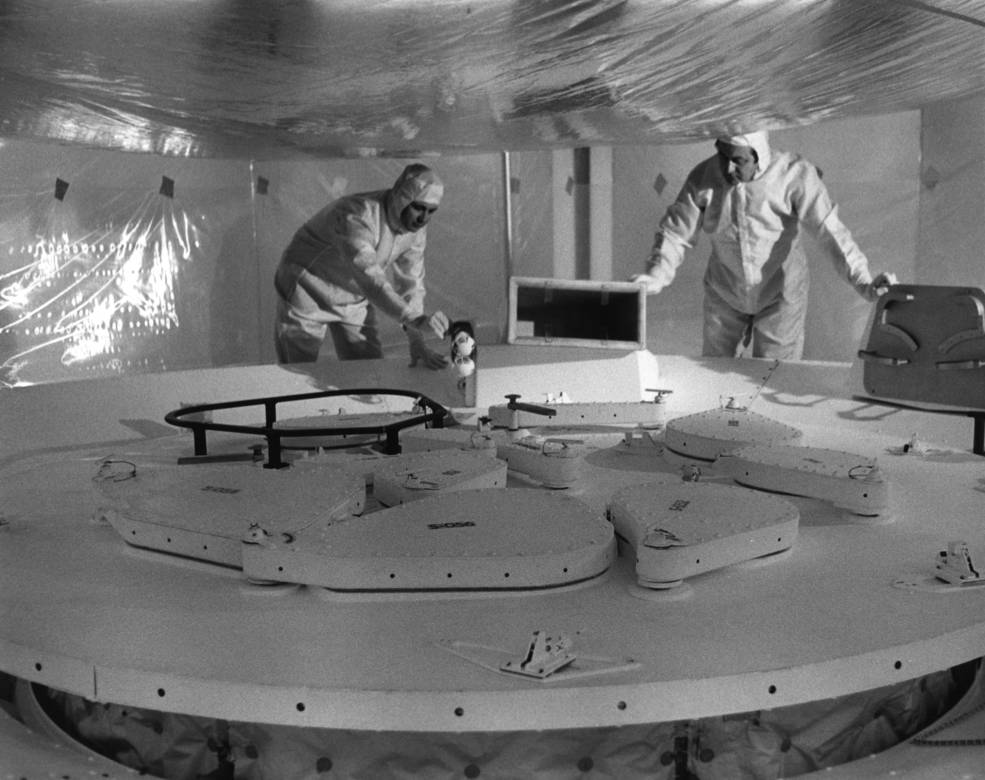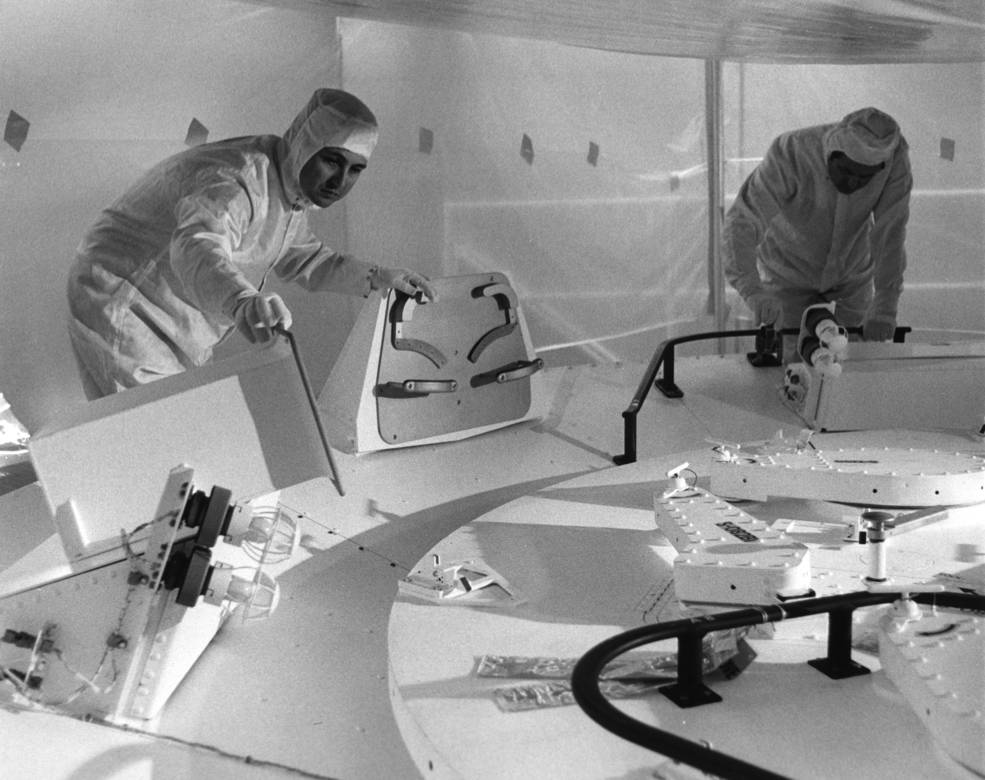In March 1973, with just two months remaining until the launch of Skylab, America’s first space station, workers at NASA’s Kennedy Space Center (KSC) in Florida continued to prepare the two Saturn rockets for the initial launches.
In March 1973, with just two months remaining until the launch of Skylab, America’s first space station, workers at NASA’s Kennedy Space Center (KSC) in Florida continued to prepare the two Saturn rockets for the initial launches. In the Vehicle Assembly Building (VAB), they continued testing of the Saturn V rocket with the Skylab 1 space station mounted on top to prepare it for its mid-April rollout to Launch Pad 39A and May 14 launch. At Launch Pad 39B, engineers prepared the Saturn IB to launch the Skylab 2 first crew on May 15. Astronauts Charles “Pete” Conrad, Dr. Joseph P. Kerwin, and Paul J. Weitz intensified their training as their launch and 28-day mission approached. NASA released the crew patches for all three Skylab crewed missions.



Three views of technicians inspecting foot restraints and handrails for use by spacewalking astronauts on the exterior of the Apollo Telescope Mount, stacked atop the Saturn V rocket in the Vehicle Assembly Building at NASA’s Kennedy Space Center in Florida.
Engineers in the VAB spent the month of March testing the Saturn V launch vehicle and loading provisions and other items into the Skylab workshop. Most of the equipment and consumables needed by all three crews had to launch prepositioned inside the space station since the Apollo capsules that brought the crews to orbit had limited resupply capability. By the end of March, technicians had loaded 70 percent of the needed provisions. Engineers also finished testing some of the scientific equipment, such as the earth resources cameras, and inspected the outside of the Apollo Telescope Mount. On March 30, the entire launch team completed a simulated countdown and liftoff of the workshop during the Flight Readiness Test, the last major milestone before the vehicle left the assembly building. Following the simulated liftoff, the exercise continued for four days, simulating the initial workshop on-orbit operations. The Skylab 2 astronauts participated in the simulated launches of both the workshop and their own spacecraft, the activation of the space station, and initial orbital operations. The tests led up to the planned mid-April rollout of the Saturn V to Pad 39A. Meanwhile, following the rollout of the Skylab 2 Saturn IB to Launch Pad 39B on Feb. 26, engineers powered up the Apollo spacecraft on March 5 to conduct spacecraft combined systems tests.



Left: Skylab 2 astronauts Dr. Joseph P. Kerwin, left, Paul J. Weitz, and Charles “Pete” Conrad eat a Skylab meal in the wardroom in the Skylab Orbital Workshop trainer at NASA’s Johnson Space Center in Houston. Middle: Conrad trains in the Multiple Docking Adapter (MDA). Right: Conrad trains on materials processing equipment in the MDA.




Left: Dr. Joseph P. Kerwin, standing, operates the controls as Paul J. Weitz undergoes a practice run in the Lower Body Negative Pressure device. Middle left: Weitz trains with the ultraviolet stellar astronomy experiment. Middle right: Charles “Pete” Conrad trains as a subject for the human vestibular function experiment as Kerwin trains as the operator. Right: Weitz prepares for a test run on the bicycle ergometer.
The Skylab 2 crew continued extensive training in the Skylab 1-g training modules in the Mission Simulation and Training Facility in Building 5 of NASA’s Johnson Space Center in Houston. The training included working the various systems of Skylab’s multiple modules, the daily life activities such as meal preparation and consumption in the wardroom, and the various experiments in biomedical sciences, materials sciences, solar physics, and Earth observations.



The crew patches for the first, left, second, and third crewed Skylab missions.
NASA released the official patches for each of the crew missions, with the astronauts’ names printed on each one. Each patch included symbols of the main scientific aspects of the Skylab program, namely studies of human physiology, Earth observations, and solar physics. The first mission’s patch showed the space station silhouetted against a stylized Earth eclipsing the Sun. The patch of the second mission displayed Leonardo da Vinci’s Vitruvian Man in front of two hemispheres representing the Sun and the Earth. And the third mission’s patch had stylized figures representing humans, a tree, and an atom. Unfortunately, the patches became the source of endless confusion over the numbering of the three missions. NASA officially designated the space station as Skylab 1 and the three crewed missions as Skylab 2, 3, and 4. However, some mission documentation labeled the crew flights as Skylab Missions 1, 2, and 3, and the crew designed their patches based on that. By the time managers discovered the miscommunication, the astronauts’ clothing with the incorrect patches had already been manufactured and stowed aboard the space station.
To be continued …
World events in March 1973:
March 1 – Capitol Records releases Pink Floyd’s album “The Dark Side of the Moon.”
March 7 – Czech astronomer Luboš Kohoutek discovers the comet that bore his name and observed by the Skylab 4 astronauts in December 1973.
March 8 – The Eisenhower Tunnel opens in Colorado, at the time the world’s highest and the longest in the U.S.
March 12 – The final episode of “Rowan and Martin’s Laugh-In” airs on NBC.
March 14 – North Vietnam releases an additional 108 American prisoners of war, including future U.S. Senator and Presidential candidate John S. McCain, captured in October 1967.
March 21 – Pieces of the Goodwill Rock, the last lunar sample collected by Apollo 17, sent to all 50 states and U.S. territories.
March 29 – The last American combat troops depart from South Vietnam.
March 30 – Bonnie Tiburzi becomes the first female commercial airline pilot when American Airlines hires her.
John Uri
NASA Johnson Space Center





























